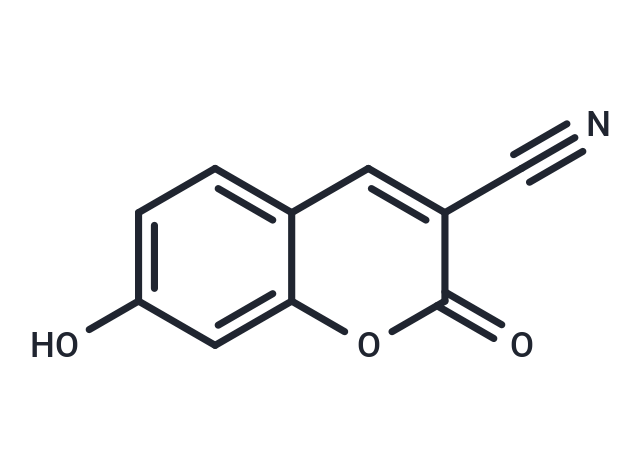Shopping Cart
Remove All Your shopping cart is currently empty
Your shopping cart is currently empty
3-Cyano-7-hydroxycoumarin (3-Cyanoumbelliferone) is a macrophage inhibitor of macrophage inhibitory factor (MIF) interconjugate isomerase with a Ki of 2.9 μM. 3-Cyano-7-hydroxycoumarin belongs to the group of coumarin derivatives, which can be used as molecular probes and fluorescent dyes.

| Pack Size | Price | USA Warehouse | Global Warehouse | Quantity |
|---|---|---|---|---|
| 200 mg | $40 | - | In Stock | |
| 500 mg | $81 | - | In Stock | |
| 1 g | $123 | - | In Stock | |
| 2 g | $179 | - | In Stock |
| Description | 3-Cyano-7-hydroxycoumarin (3-Cyanoumbelliferone) is a macrophage inhibitor of macrophage inhibitory factor (MIF) interconjugate isomerase with a Ki of 2.9 μM. 3-Cyano-7-hydroxycoumarin belongs to the group of coumarin derivatives, which can be used as molecular probes and fluorescent dyes. |
| Targets&IC50 | MIF:2.9 μM(Ki) |
| In vitro | Instructions I. Solution preparation 1. Preparation of mother solution and working solution: It can be dissolved in DMSO and further diluted to aqueous buffer solution as working solution in the experiment. II. Operation steps 1. Sample preparation Target molecule: This probe is mainly used to detect MIF activity, or as a general fluorescent dye. It can be used to study the role of MIF in inflammation, cancer and immune response. Concentration: For fluorescence experiments, a solution with a concentration of 1–10 μM is usually used, and the specific concentration is adjusted according to the sensitivity and requirements of the experiment. 2. Experimental conditions 1) Buffer selection: In order to study MIF inhibition, it is recommended to select a suitable buffer (such as phosphate buffer with a pH range of 7.0–7.5) to simulate physiological conditions. 2) Add 3-Cyano-7-hydroxycoumarin: Add an appropriate amount of 3-Cyano-7-hydroxycoumarin solution (usually 0.1–1 mM) to the sample. 3) Reaction temperature and time: Typically, the reaction temperature is room temperature to 37°C. The reaction time depends on the activity of the enzyme in the sample and is usually between 30 minutes and 1 hour. 4) Hydrogen peroxide (H₂O₂) is usually added as an oxidant to initiate the reaction. 5) Color change: After the reaction is completed, the product is usually brown or dark in color and can be quantitatively detected using colorimetric methods (such as UV-Vis spectrophotometer). 3. Fluorescence imaging 3-Cyano-7-hydroxycoumarin can be used as a fluorescent probe to track molecular interactions or the activity of biomolecules such as MIF in live cell imaging. Detection: Fluorescence intensity is quantified by fluorescence microplate reader, confocal microscopy or flow cytometry. 4. Inhibition assay For MIF tautomerase inhibition assay, 3-Cyano-7-hydroxycoumarin can be used to determine its inhibitory potency with a Ki value of 2.9 μM. Methods: The inhibition of MIF by 3-Cyano-7-hydroxycoumarin was evaluated by measuring the fluorescence quenching effect. Storage conditions 1) 3-Cyano-7-hydroxycoumarin should be stored in a dry, cool place at -20°C, away from light and moisture. 2) The solution should be freshly prepared and, if storage is required, should be stored at -20°C or below and away from light. |
| Synonyms | 3-Cyanoumbelliferone |
| Molecular Weight | 187.15 |
| Formula | C10H5NO3 |
| Cas No. | 19088-73-4 |
| Smiles | Oc1ccc2cc(C#N)c(=O)oc2c1 |
| Storage | Powder: -20°C for 3 years | In solvent: -80°C for 1 year | Shipping with blue ice/Shipping at ambient temperature. | ||||||||||||||||||||||||||||||
| Solubility Information | DMSO: 15 mg/mL (80.15 mM), Sonication is recommended. | ||||||||||||||||||||||||||||||
Solution Preparation Table | |||||||||||||||||||||||||||||||
DMSO
| |||||||||||||||||||||||||||||||
| Size | Quantity | Unit Price | Amount | Operation |
|---|

Copyright © 2015-2025 TargetMol Chemicals Inc. All Rights Reserved.